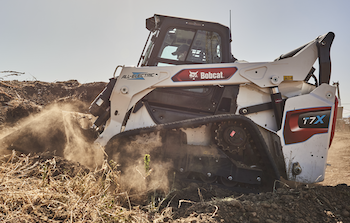Technology Update -- The shift to electrification
As OEMs work toward powering equipment with electricity,no one-size-fits-all option exists.
by Brianna Jackson
As vehicle electrification accelerates, the role of the hydraulic system is being more closely examined. Battery life is paramount in electrified architectures and hydraulics have traditionally been an energy-taxing technology. Improvements in the hydraulic system is key to enabling a longer battery life for electrified vehicles.
 |
|
Bobcat recently unveiled its electric compact track loader, the T7X. Aside from its electric powertrain, one of the vehicle’s most interesting design features is the replacement of hydraulic cylinders with ball-screw mechanical actuators. |
So far, vehicle OEMs have explored a variety of solutions aimed at improving the efficiency of their vehicles. Within hydraulics, these changes range from incorporating novel technology to redesigning the entire system. Through trialing these new components and systems, one thing is clear: improving vehicle efficiency through the hydraulic system will not be a one-size-fits-all solution. Factors such as vehicle size, operating conditions, duty cycle and the degree of control an application requires determines the viability of the solution. As OEMs strive to achieve electrification, these factors must find a balance between efficiency and practicality.
There are challenges that traditional hydraulic architectures face in the wake of electrified off-highway vehicles and there are pros and cons of emerging hydraulic technologies.
Status quo must change
The advantage of traditional hydraulic systems has always been their ability to achieve unmatched power density at a very low cost. From a vehicle OEM perspective, this benefit was so great that the efficiencies in the hydraulic system became an afterthought. While vehicle OEMs are not quick to eliminate or even alter this tried-and-true technology, hydraulic systems will need a significant boost in energy efficiency to accommodate electrification.
Some OEMs are electrifying certain portions of their portfolios. One example where electrification is emergeing is in electric mini excavators. The estimated market for hydraulics sold to this vehicle type to be approximately $1.6 billion in 2021. Given the size, these vehicles will be a fertile testing ground for new hydraulic technology. Here’s the technology being used in these models:
Electromechanical actuators: What they lack in power density, they make up for in other ways. Bobcat recently unveiled its electric compact track loader, the T7X. Aside from its electric powertrain, one of the vehicle’s most interesting design features is the replacement of hydraulic cylinders with ball-screw mechanical actuators. Electromechanical actuators have an advantage in maintenance over hydraulic systems. However, the most pressing constraint of replacing hydraulic cylinders is a loss of power density. However, in applications with low power-density requirements, electromechanical actuation offers tighter control and less noise. Additionally, within an electrified vehicle, the removal of the hydraulic system can simplify the overall design.
The best-use cases for replacing hydraulic cylinders with electromechanical actuators are found within the material handling sector such as aerial work platforms and telehandlers. In the right applications, replacing hydraulic actuation with electromechanical actuation can lead to a lower total cost of ownership (TCO) from fuel savings, reduced maintenance costs and tax subsidies associated with implementing green technology.
Digital Hydraulics: Digital hydraulics gets its name from the fast-switching on/off valves used in this system. This technology tends to carry significantly higher efficiencies when used in place of traditional hydraulic components. Over the past few years, there have been a variety of digital hydraulic solutions released.
In late 2020, Volvo announced a partnership with Norrhydro to produce an electric excavator. Norrhydro’s proprietary technology, the NorrDigi system, features a multichambered digital hydraulic actuator. This modular system reduces the bill of materials significantly by eliminating the main control valve and shortening the length of hosing required. The higher
efficiencies brought by the digital hydraulic system also supports a longer battery life, which is key to making electric excavators a practical solution.
Another example in the digital hydraulic space is Danfoss’s widely discussed Digital Displacement Pump (DDP). This pump has been shown to increase fuel efficiency by 30 percent in intrnal combustion engine-powered vehicles. The technology is promising as a successor to traditional hydraulics and Danfoss is positioned as an early mover in the digital hydraulic space.
Digital hydraulics offer enhanced efficiencies while largely maintaining traditional hydraulic architectures. By maintaining traditional architectures, many of the drawbacks faced by other solutions such as electromechanical actuators, are avoided. More digital hydraulic technologies will likely be introduced as the off-highway vehicle market moves towards electrification.
Electro-hydraulic actuation: Electro-hydraulic actuation involves each actuator being driven by its own pump and motor. This reduces throttling losses from valves and the modular nature of the technology can simplify machine maintenance.
Additionally, separating the drivetrain from the working functions simplifies machine design when going electric. One example of an electro-hydraulic actuator is Bucher’s HELAX system. According to Bucher, the system is significantly more efficient than traditionally actuated systems. One way it achieves this higher efficiency is through an energy recuperation process. Traditional hydraulic systems need an accumulator, but HELAX offers the ability to regenerate power back into the battery through the electric motors that drive the system.
The main drawback to electro-hydraulic solutions is the increased upfront costs that can be several orders of magnitude higher than traditional hydraulic actuation. However, for the long-term TCO, higher efficiencies could significantly reduce the total operating costs. For this reason, electro-hydraulic architectures are continuing to gain interest from many OEMs.
Final thoughts
Electrification has undoubtedly shaken up the mature mobile hydraulics market. Although no one way forward is clear, it is apparent that a one-size-fits-all solution to optimize vehicle efficiency does not exist.
The variety of vehicles, applications and requirements within the off-highway market will continue to challenge mobile hydraulic suppliers. However, this will also offer suppliers an opportunity to innovate as OEMs progress toward electrifying their fleets.
Brianna Jackson is a research analyst at Interact Analysis, and international technology research firm. This story originally appeared in the September-October 2022 issue of Pro Contractor Rentals magazine. ©2022 Urbain Communications LLC. All rights reserved.








